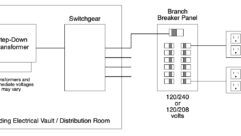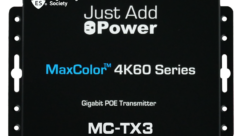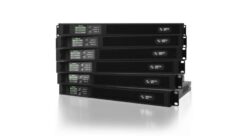
Power Up
Jun 1, 2004 12:00 PM,
By Mike Klasco
Monster AVS 2000
Power protection and regulation devices have become common for computer gear. Yet these are also necessary components for both AV permanent install and touring systems. What is all this power stuff about anyway? When and why are they needed, and who makes what?
Most systems integrators have been doing installations for years and never bothered with power line conditioners, surge protectors, balanced power, uninterruptible power supplies (UPS), sequential turn-on, voltage stabilizers, and so on. Those integrators smart enough to get into trouble know that most well-designed products already have a varistor spike absorber or similar protection against power line disturbances.
So why are so many consultants and sound contractors specifying and installing power line gear? Perhaps the most compelling reason for that includes the degraded AC power people now live with. It is not just installations in lightning territory fed by outdoor power lines, AV systems being feed nasty power on cruise ships, nor just installations in developing countries.
Each month a commercial facility will experience about 60 transient events and 50 surges of varying severity and duration.

DISTURBING
Power disturbances include lightning, low-voltage brownouts during the summer, the garbage from relays in an air-conditioning system (or relays in the cash register), dimmers and lighting effects equipment, the stuff spilling from that old digital effects processor the customer insisted on using, control signals, and even modulated RF signals on the power line. New York has suffered brownouts in the summers for decades, and more recently, California has had its share of low line voltage and rolling blackouts. Aside from out-of-bounds voltage from the power line, AV systems can contaminate themselves. The increasing popularity of switching power supplies in all sorts of equipment from DVD players to power amps contributes harmonics into the power line (not to mention EMI), and certain topologies of switching supplies that really ought not to be used can chew up the power line.
Although quality audio components have used internal surge protection in the past, the trend for higher and higher watts per dollar has so squeezed product designers that a more minimalist approach is now the norm. Besides, wouldn’t you rather have your first line of defense be the line conditioner so that it takes the hit and goes down? The alternative is to remove a varistor in the power amplifier and then have to provide a loaner and take the amp for a visit back to the shop!
There are half a dozen functions that power processors can serve, singly or in combination, from simple surge protection, power regulation, balanced power, sequential turn-on, and uninterruptible (backup) power to catastrophic shutdown — such as when a 110V power condition system is inadvertently plugged in to 220V power.
FSR SPC-15

In the future, expect to see smarter power processing such as remote switching, system control and load monitoring down the power line, and, with more efficient and agile amplifiers as well as homeland security paranoia, uninterruptible power supplies for power amp emergency operation when the power fails altogether. Because there are just too many outfits that make too many variations of these devices to cover them all, I have picked out some of the more popular units to talk about in each category.
POWER CONDITIONERS
Power line conditioners have become popular because of computer and digital equipment (digital effects processors) sensitivity to even very short-term power spikes. Power conditioners are less expensive than regulators, and for most applications, they provide adequate protection. These line conditioners protect electronic equipment by combining a high-voltage surge and transient suppressor with an RFI/EMI interference filter. The filter works to prevent noise from fluorescent lights, electric motors, radio transmitters, and similar sources of electronic pollution from leaking from the AC line into both analog and digital circuits. Typically, a varistor clamping suppression circuit responds in nanoseconds, clamping spikes and surges to safe levels. A large power spike can do a lot of damage, and though the basic power products do not attempt to stabilize voltage, they do deal with surges. It is not uncommon for a basic surge protector/line conditioner to be described as a voltage stabilizer, but that is a far more ambitious animal that I will get to shortly. Generally, these surge protector/RF line filters are integrated into a power distribution panel package.
The PS 4×4 from Applied Research and Technology (ART) is designed to protect equipment from electric surges and spikes. The unit also has RFI and EMI filtering, a 15-amp breaker, and a total power capacity of 1,800W. The PS 4×4 also features a front-located on/off power switch and a frontmounted circuit breaker reset switch.
Furman Sound claims that its Pro series can safely absorb and dissipate large spikes from nearby lightning strikes as well as from other sources (as much as 11,000 amps across any wiring mode: hot-neutral, hot-ground, or neutral-ground). This series is rated at 20 amps/2,400W for larger power amps or for installations in problematic areas.
The Furman Sound Series II consists of the PL-Pro II, PL-Pro D II, PM-Pro II, and PS-Pro II (from top).

Juice Goose combines noise filtration and surge suppression in the RX Series, which reduces common mode noise while limiting normal mode noise and also features Smart Sensor Technology, which provides protection from long-duration overvoltages (which would cause a basic varistor component to fail).
SurgeX features its patented Series Mode transient protection, which it says is capable of stopping multiple surges of up to 6,000V. Rated at 20 amps, the SX2120 has 14 standard-grounded AC receptacles on the back panel with advanced EMI/RFI filtering.
Another form of power conditioning is balanced power. Equi-Tech was the first to offer commercial balanced power products and have a line of products for commercial applications as well as high-resolution audio and high-definition video applications. Balanced power topology delivers electrical energy to electronic equipment power supplies in a different way from any other system of AC power delivery. Typical power circuits in the United States are nominally 120V to ground. In a balanced power system, the voltage to ground is only half of that (60V). Because this is AC power, the two mains alternate between plus and minus, 60 times per second, but always opposite each other, always 120V (RMS) apart from each other. Balanced power consists of two 60V to ground AC conductors that are inversely phased. With inverse phasing, the normal 120V is still present between the two main wires in the power circuit. The power supplies of your devices after this unit still see 120V as usual, so everything works. The advantage of this scheme is reduced noise.
SurgeX SX2120-SEQ

VOLTAGE REGULATORSVoltage regulators are used for protection from problems that are caused by power line sags, brownouts, overvoltages, or unstable power sources, such as when the system is to be powered off a generator — just about everything short of complete loss of power. Regulation can be by ferroresonant transformers, variable tap transformer systems, or switching power supplies. Ferroresonant transformers and variable tap transformers have been the established solution. Low-power gear-switching supplies for power regulation are all over the place, and they can be found in just about every laptop computer and other universal power supplies in consumer products.Juice Goose offers the FE Series for power regulation that delivers a constant 120V of isolated, clean power. The special ferroresonant transformer system contains two separate electromagnetic paths with limited coupling between them. This design electronically isolates incoming current equipment and regenerates stable, clean power. The FE series is designed to withstand harsh electrical environments.Furman provides the AR-Pro voltage regulator for AC from 88V to 134V, with output at 120V. Loads up to 30 amps can be handled with 120V input, with derating for lower voltage input. Twelve outlets are provided on the rear, with another two on the front panel.Monster’s AVS 2000 is designed to stabilize power line fluctuations and maintain constant 120V output up to 15 amps when AC input fluctuates anywhere from 80V to 140V. Internally, a variable tap transformer as well as a motorized servo scheme constantly compensate for both the input power variations and output load requirements.SEQUENTIAL TURN-ON CONTROLLERSThese gizmos will turn on equipment with a time delay, with some of the power outlets being activated before others. About 20 years ago, several high-performance audio integrated circuits (IC) began to appear that had decent sound quality and specs, but when they were powered up as the DC supply rails ramped up to a few volts, the IC would send garbage through their outputs for the first second or two after they woke up. Powering down usually was the same story.Today this problem still exists with many of the analog ICs that audio engineers would otherwise prefer to use. Because many audio components are built on tight design budgets, there often is not enough money to buy both these high-performance ICs (with the nasty response to their wake-up call) and also add a relay, an optocoupler, or another turn-on mute for the output. So often it is a race to see if the installation’s amplifiers will turn on before the audio mixers and signal-processing electronics are done belching. If the turn-on junk makes it through the amplifiers, then the sound system’s speakers are in for a rough time. Unmuted turn-on transients are the cause of excessive wear and tear and perhaps even premature failure, especially in the case of compression drivers that are biamped and directly coupled to the power amps (a crossover capacitor selected for an octave below the intended crossover point isn’t a bad idea, by the way).Aside from turn-on/turn-off transients, sequential turn-on/off reduces the potential for tripped circuit breakers, blown fuses, or voltage spikes caused by simultaneous power application. There are not many excuses for leaving this out of any job. Here are a few examples:Atlas/Soundolier offers the SACR-191, a six-circuit sequencer designed to sequentially activate the SACS-1 and SACS-5 power outlets. The delay is adjustable up to ten seconds, and a remote startup/shutdown switch can be connected.Middle Atlantic Products’ USC-6R universal sequencing controller provides six-step sequencing control to AC power distribution systems that can be controlled by either switch closure or 12 VDC. Sequencing can be initiated locally as well as remotely. The unit features an interval delay selector of one, three, or six seconds between sequence steps. Also provided are four start delay settings, which allows for as many as three units to be linked and function as a single 18-step unit.FSR offers a range of line sequential AC power switchers to handle small applications to epic sound systems. FSR’s sequencers feature solid-state, zero crossing AC power switching, surge suppression on all AC outlets, short-circuit protection for all control inputs and outputs, as well as sequential switching.The Furman PS-8 II absorbs spikes, surges, and RF interference. It also powers up a rack full of equipment in a predetermined three-step delay sequence, with the sequence reversed for power-down. The PL-Plus adds line voltage display and enhanced RFI filtering, while the PM-8 dumps the rack lights but has both volts and ammeters. All of the products are rated at 15 amps.The SurgeX SEQ boasts the ability to sequentially power up/down electronic devices in separate groups. Based on the SurgeX SX2120, the SEQ offers guaranteed surge protection and power conditioning for as many as 14 pieces of sensitive electronic equipment.ETA Systems’ PS220 two-channel sequential unit can operate as a standalone module and with any 2- or 4-channel unit that is equipped with ETA’s sequential and linkable daisy-chain technology. It is specifically designed for remote turn-on and linking in master or slave combinations. That is accomplished by the unit’s self-contained power supply, which includes a three-wire, low-voltage maintained connection interface as well as expandable daisy-chain communication ports.Whitenton Industries pioneered power conditioning for pro audio with its Juice Goose products. The CQ15A sequenced power system features remote-control capability, 11 outlets on the rear of the chassis, and a total of 15 amperes. The CQ family can be remotely activated with a progressive delay of two seconds per unit. Five sequenced turn-ons are provided, with two outlets each, with the last outlet unswitched. All outputs have both surge and spike protection, as well as noise filtering.For More InformationApplied Research and Technology (ART)
www.artproaudio.comAtlas/Soundolier
www.atlas-soundolier.comEqui-Tech Corp.
www.equitech.comETA Systems
www.etasys.comFalcon Electric
www.falconups.comFSR
www.fsrinc.comFurman Sound
www.furmansound.comJuice Goose
www.juicegoose.comMiddle Atlantic Products
www.middleatlantic.comMonster
www.monstercable.comSurgeX
www.surgex.com










